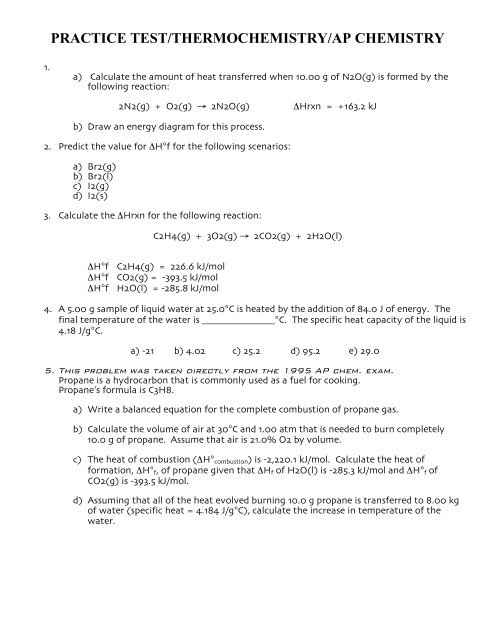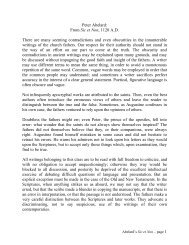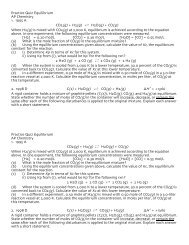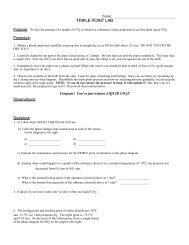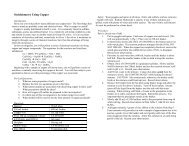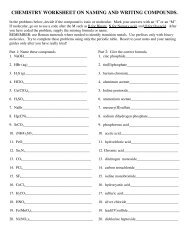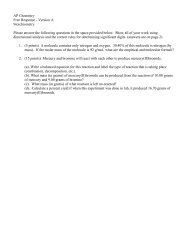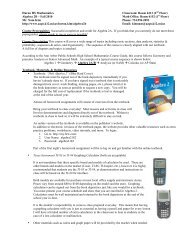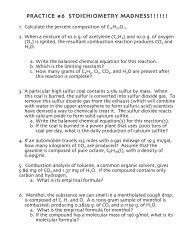PRACTICE TEST/THERMOCHEMISTRY/AP CHEMISTRY
PRACTICE TEST/THERMOCHEMISTRY/AP CHEMISTRY
PRACTICE TEST/THERMOCHEMISTRY/AP CHEMISTRY
You also want an ePaper? Increase the reach of your titles
YUMPU automatically turns print PDFs into web optimized ePapers that Google loves.
<strong>PRACTICE</strong> <strong>TEST</strong>/<strong>THERMO<strong>CHEMISTRY</strong></strong>/<strong>AP</strong> <strong>CHEMISTRY</strong><br />
1.<br />
a) Calculate the amount of heat transferred when 10.00 g of N2O(g) is formed by the<br />
following reaction:<br />
2N2(g) + O2(g) → 2N2O(g)<br />
ΔHrxn = +163.2 kJ<br />
b) Draw an energy diagram for this process.<br />
2. Predict the value for ΔH°f for the following scenarios:<br />
a) Br2(g)<br />
b) Br2(l)<br />
c) I2(g)<br />
d) I2(s)<br />
3. Calculate the ΔHrxn for the following reaction:<br />
C2H4(g) + 3O2(g) → 2CO2(g) + 2H2O(l)<br />
ΔH°f C2H4(g) = 226.6 kJ/mol<br />
ΔH°f CO2(g) = -393.5 kJ/mol<br />
ΔH°f H2O(l) = -285.8 kJ/mol<br />
4. A 5.00 g sample of liquid water at 25.0°C is heated by the addition of 84.0 J of energy. The<br />
final temperature of the water is _______________°C. The specific heat capacity of the liquid is<br />
4.18 J/g°C.<br />
a) -21 b) 4.02 c) 25.2 d) 95.2 e) 29.0<br />
5. This problem was taken directly from the 1995 <strong>AP</strong> chem. exam.<br />
Propane is a hydrocarbon that is commonly used as a fuel for cooking.<br />
Propane’s formula is C3H8.<br />
a) Write a balanced equation for the complete combustion of propane gas.<br />
b) Calculate the volume of air at 30°C and 1.00 atm that is needed to burn completely<br />
10.0 g of propane. Assume that air is 21.0% O2 by volume.<br />
c) The heat of combustion (ΔH° combustion ) is -2,220.1 kJ/mol. Calculate the heat of<br />
formation, ΔH° f , of propane given that ΔH f of H2O(l) is -285.3 kJ/mol and ΔH° f of<br />
CO2(g) is -393.5 kJ/mol.<br />
d) Assuming that all of the heat evolved burning 10.0 g propane is transferred to 8.00 kg<br />
of water (specific heat = 4.184 J/g°C), calculate the increase in temperature of the<br />
water.
ANSWERS TO <strong>PRACTICE</strong> <strong>TEST</strong>:<br />
1.<br />
a) 10.00 g of N2O(g) X 1 mol N2O(g)/44.02 g X 163.2 kJ/2 moles N2O(g) = 18.54 kJ (endothermic)<br />
b) ENERGY DIAGRAM:<br />
↑<br />
E<br />
2N2O products<br />
_____________<br />
/ I<br />
2N2 + O2 / +ΔH<br />
__________/ I<br />
reactants<br />
RXN PROGRESS →<br />
2.<br />
a) Br2(g) is > 0 This is because elemental Br2 is a liquid. Therefore, energy must be added (+) to<br />
the liquid in order for it to become a gas.<br />
b) Br2(l) = 0 This is because it is in its pure elemental form.<br />
c) I2(g) = > 0 This is because elemental I2 is a solid. Therefore, energy must be added (+) to<br />
the solid in order for it to become a gas.<br />
d) I2(s) = 0 This is because it is in its pure elemental form.<br />
3.<br />
ΔH°rxn = ΣnΔH°f (products) - ΣmΔH°f (reactants)<br />
ΔH°rxn = Σ2[(ΔH°f CO2(g)) + 2(ΔH°f H2O(l))] - [1(ΔH°f C2H4(g)) + 3(ΔH°f O2(g))]<br />
ΔH°rxn = [2(-393.5 kJ/mol) + 2(-285.3 kJ/mol)] - [1(226.6 kJ/mol) + 3(0)]<br />
ΔH°rxn = (-787.0 kJ + -570.6 kJ) - (226.6 kJ/mol) = -1584.2 kJ/mol of C2H4 combusted<br />
4.<br />
The answer is E.<br />
Work:<br />
q = (msΔT)<br />
84.0 J = [(5.00 g)(4.184 J/g°C)(T f – 25.0°C)]<br />
84.0 J = (20.92 J/°C)(T f - 25.0°C)<br />
84.0 J = -20.92 T f - 523 J<br />
607 J = -20.92T f Tf = 29.0°C
5.<br />
a) C3H8(l) + 5O2(g) → 3CO2(g) + 4H2O(l)<br />
b) we haven’t done gas laws yet, but . . . .<br />
10.0 g C3H8 X 1 mol C3H8/44.11 g C3H8 X 5 mol O2/1 mol C3H8 = 1.13 moles O2 =<br />
moles pure O2 needed.<br />
Since the ideal gas law says, PV = nRT<br />
(p=pressure in atm, V = volume in L, n = moles, R is a constant, and T = temperature in Kelvin)<br />
So, V = nRT/P<br />
V of pure O2 = 1.13 moles(0.0821Latm/molK)(303K)/1.oo atm = 28.1 Liters pure O2<br />
So, if O2 is 21.0% of air . . . .<br />
(X Liters of air)(.210) = 28.1 28.1/.210 = 134 Liters of air.<br />
c) C3H8(l) + 5O2(g) → 3CO2(g) + 4H2O(l) ΔH° rxn = -2,220.1 kJ/mol<br />
ΔH° rxn = ΣnΔH°f products - ΣmΔH°f reactants<br />
-2,220.1 kJ/mol = [3(-393.5 kJ) + 4(-285.3 kJ)] – [ΔH°f C3H8 + 5(0 kJ)]<br />
-2,220.1 kJ/mol = [-1180.5 kJ + -1141.2 kJ] – ΔH°f C3H8<br />
-2,220.1 kJ/mol = -2321.7 kJ – ΔH°f C3H8 → ΔH°f C3H8 = -101.6 kJ/mol<br />
d)10.0 g C3H8 X 1 mol C3H8/44.11 g X -2220.1 kJ/1mol = -503.3 kJ<br />
qrxn = -(qH2O + qcal) there is no calorimeter heat capacity provided, so omit this . .<br />
qrxn = -(qH2O) → -503,000 J = -[(8.oo kg X 1000 g/kg)(4.184 J/g°C)( ΔT)<br />
-503,000 J = -33472 J/°C ΔT → 15.0°C = ΔT


